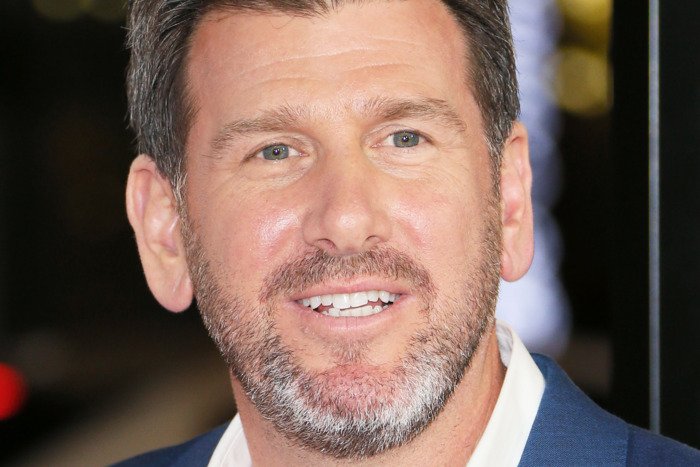
Cinematographer Lawrence Sher drew inspiration and influence from the 70s and 80s, but also supplanted in a multi-tiered dimension of cinematography through lighting, camera placement, camera movement, lensing, and color within Joker. The main goal was to connect the audience into the character and the journey that Arthur (Joaquin Phoenix) takes.
The film played with light and shadows as that demonstrated how Arthur wrestled with two sides of himself, one being hopeful and the other that strives for chaos. The cinematographer explained, “Which side is his true self and which shadow that follows the ground when we walk around each day, half that shadow is our true self, our darkest self. Some of that came in subtle ways of which I tried to start the movie in fuller frontal light with Arthur. As he progresses later in the movie, he moves physically into the shadow and into more silhouette. They’re meant to be quite subtle, but they provide a structure that can provide an arc to the character from a lighting standpoint.”
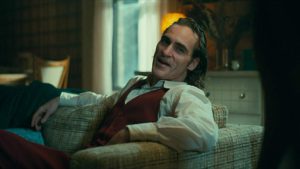
The camera angles and lensing are also used psychologically to transport the audience in the mind of Arthur’s perspective in how he see’s the world. “Early in the movie, the camera has longer lens and further away from him when he’s in public to show he’s insignificant in those frames from a compositional standpoint. When the kids beat him up and after he’s knocked down, we suddenly are on a wider lens, physically closer to him. Basically, we slowly draw ourselves in by getting the camera closer and closer to Arthur. We’re literally within two or three feet of him, so that psychology of how the audience received that on the screen comes through in a subtle way where we’re trying to connect with him through the lens and the lighting. There was a philosophy in which I never wanted the camera to be at eye level. We put the camera at a place that could be high, could be a little bit low, but it was never trying to be at eye level, even if it was just suddenly lower than that or sometimes quite low. The first time we meet Sophie, his neighbor, that wide shot is severely low on Arthur when he stops the door and then tilts up as they walk in. These odd angles fracture and make the audience just subconsciously sense that this character is not quite as normal as perhaps the world around it. We found ways to set the framing in an angle that we’re not necessarily used to seeing all the time,” Sher described.
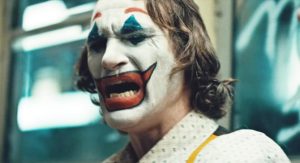
The film featured both static and hand-held camera shots. Sher continued, “We often used hand-held with him to give us some flexibility, but also to allow it to almost be swimming around him and be able to adjust with him, so if he moved or made adjustments, we always had the ability to move with him to allow us to stay connected, literally physically connected to his movements. We did have static compositional shots, but we juxtaposed those depending on the emotion of the scene and what the intent we wanted the scene to be very static or small, very tension filled camera moves. The camera movement in the movie is subtle, but it’s present a lot of the movie. Often, it’s moving in linear ways, left side to side and more forward back. We never did things like crane shots. We wanted the movie to always feel very grounded and very handmade.”
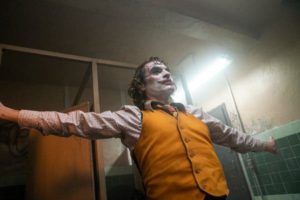
Color is utilized in a creative fashion in Joker with essentially four colors. “There’s the cyan from cool white, warm white yellow, slightly green, tungsten light, and then there’s daylight. It’s just mixing those lights in a way that could subtlety draw out of his state of mind. In his apartment, when the TV is on, we wanted to make it a blue light to represent his loneliness. In the kitchen, we added that cyan under tab light mixed with the sodium vapor street lights. We have this mix of color contrast that I’ve always found really interesting and provide depth within a frame even when their values are very similar. We’re going on streets and shooting in a bar that would have some weird fluorescent in the corner that was super cyan and then other part of the corner, there would be one that was warm light and it would be really yellow, green, and there’d be daylight slowly that was uncorrected that was blue cyan and that would be mixed with some neon. Suddenly we’re mixing all these weird colors and it just made the city feel alive with texture and messiness, nothing felt super controlled,” said the director of photography.
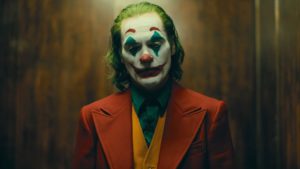
Joker applied precise lighting, camera angles, camera movement, lensing, and color in a creative and engaging means to insert the audience inside the mind of Arthur Fleck and his changing perspective of the world. This is Lawrence Sher’s first Oscar nomination in the category of Best Achievement in Cinematography with over 15 nominations in other awards. Sher has collaborated with director Todd Phillips on numerous occasions on multiple films.
“When Todd and I talk about scenes, we really talk about the emotion of the scene. Once the emotion of the scene is defined, the point of view of it, what the state of mind of the character is, where they are in this journey, we then start to assign the rules based on those things.”





